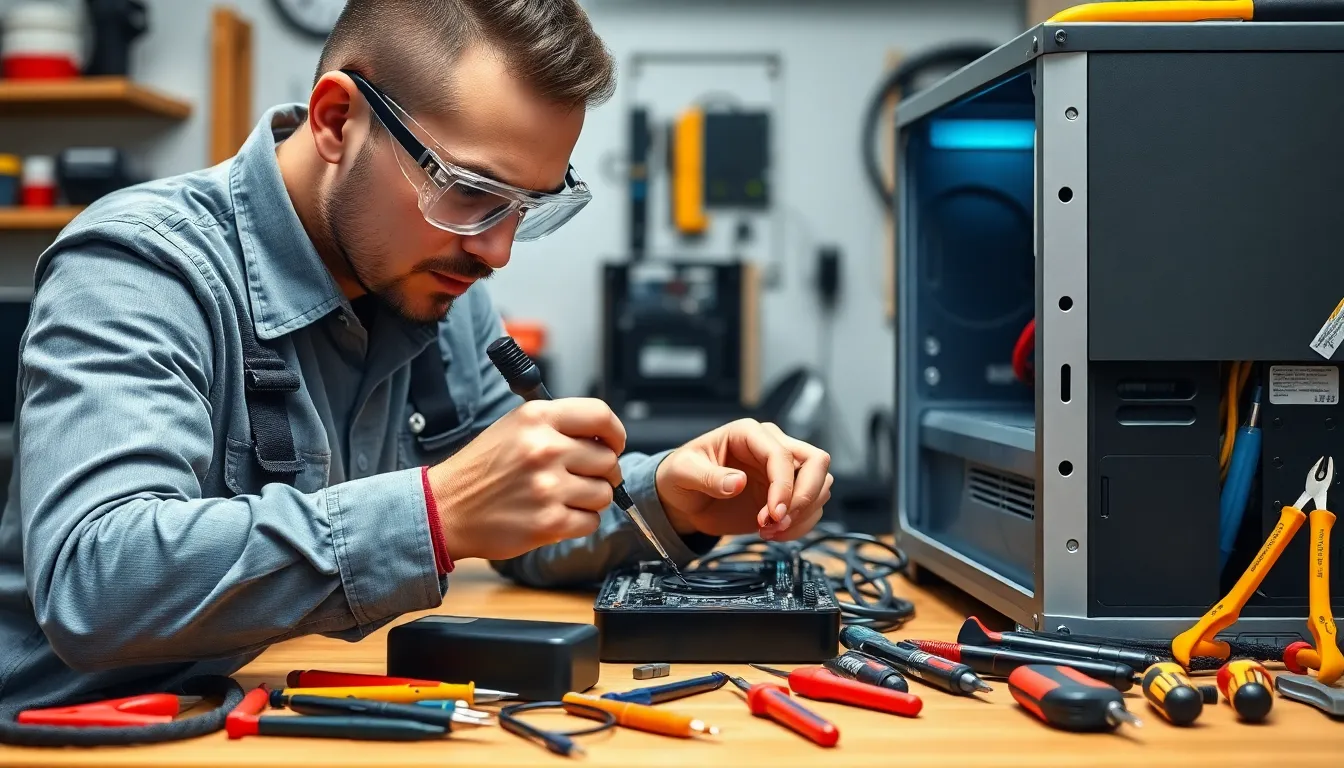In a world where technology rules, a malfunctioning PC can feel like a bad breakup—frustrating and downright inconvenient. Whether it’s a stubborn hard drive or a graphics card that has decided to take an unscheduled vacation, knowing how to tackle PC hardware repair can save the day. It’s not just about fixing what’s broken; it’s about breathing new life into that trusty machine.
PC Hardware Repair
Understanding the nuances of PC hardware repair equips users to tackle common issues and prolong their hardware’s lifespan. Hardware failure can arise for various reasons, and recognizing these can facilitate prompt repairs.
Common Reasons for Hardware Failure
Overheating often leads to hardware failure. Components that generate excess heat, like graphics cards and CPUs, require proper cooling for efficient operation. Age also plays a significant role; older components naturally become less reliable. Dust accumulation can obstruct airflow, leading to overheating and mechanical issues. Power surges or fluctuations can damage internal components, resulting in failures. Lastly, physical damage from impacts or mishandling often leads to broken parts, leading to significant malfunctions.
Signs Your PC Needs Repair
Unusual noises from the hardware serve as a clear indication that repairs are necessary. Frequent crashes or blue screens suggest potential hardware issues that require immediate attention. A sluggish performance compared to previous speeds may indicate failing components. Connectivity problems, particularly with peripherals, also signal that hardware repair is imminent. Lastly, unexpected shutdowns or restarts often denote underlying hardware malfunctions demanding prompt investigation.
Essential Tools for PC Hardware Repair

Having the right tools makes PC hardware repair efficient and successful. Proper tools minimize frustration and simplify the repair process.
Must-Have Tools for Beginners
Screwdrivers, especially Phillips and flathead types, are vital for opening computer cases. Anti-static wrist straps prevent electrostatic discharge while handling sensitive components. Thermal paste ensures optimal heat transfer between CPUs and coolers. Plier sets come in handy for gripping cables and connectors. A multimeter allows users to check for electrical continuity and measure voltage. These tools create a solid foundation for anyone starting PC hardware repair.
Advanced Tools for Professionals
Oscilloscopes provide in-depth analysis of signal integrity in circuits. Card testers assess the functionality of motherboards and add-on cards. Power supply testers verify voltage levels and overall health of power supplies. Professional-grade thermal cameras detect overheating components. A tool kit may include specialized tools such as a soldering iron for circuit repairs. Investing in these tools enables professionals to tackle complex hardware issues with confidence.
Step-by-Step Guide to Common Repairs
Repairing PC hardware can enhance performance and extend lifespan. Below are common repair tasks that anyone can tackle with the right approach.
Replacing a Failing Hard Drive
Identifying a failing hard drive often involves listening for unusual noises, which may indicate mechanical failure. To replace it, first back up important data. Next, power down the computer, unplug it, and open the case. Remove the old hard drive by detaching cables and unscrewing it from the mounting bracket. Insert the new hard drive into the bracket, securing it with screws. Reconnect the power and data cables. After that, ensure the BIOS detects the new hard drive before booting the operating system. Finally, restore data from backups to complete the process.
Fixing Overheating Issues
Overheating issues arise from dust buildup and inadequate cooling. First, power down the system and unplug it. Use compressed air to clean out the dust from fans and vents. Inspect the thermal paste on the CPU. If it appears dry, clean the old paste and apply a new layer. Next, ensure that all fans are functioning properly and that airflow within the case is unrestricted. Consider upgrading cooling solutions, such as adding more fans or replacing the CPU cooler. Monitoring software can help keep track of temperatures during use, indicating whether the fixes are effective.
Preventive Maintenance for Your PC
Preventive maintenance plays a crucial role in extending the life of a PC. Simple practices can significantly enhance performance and reliability.
Regular Cleaning and Dusting
Maintaining cleanliness inside the PC case prevents overheating. Dust accumulation can block airflow, leading to hardware failure. Users should regularly open the case and use compressed air to eliminate dust from fans, heatsinks, and components. Cleaning peripherals like keyboards and mouse surfaces also enhances user experience. Schedule cleanings every few months, especially in dust-prone environments, to keep systems running smoothly.
Upgrading Components for Longevity
Replacing aging components keeps a PC functional and efficient. Users benefit from upgrading essential parts like RAM and storage drives, as newer models provide better performance and speed. Consider replacing hard drives with solid-state drives, which offer faster data access and improved reliability. Updating the graphics card can enhance gaming and design capabilities significantly. Investing in quality components not only boosts performance but also extends the overall lifespan of the system. Regular upgrades can prevent obsolescence and ensure the PC remains competitive for years.
Conclusion
Mastering PC hardware repair is essential for anyone looking to maintain their system’s performance and longevity. By understanding common issues and having the right tools on hand, users can tackle repairs with confidence. Regular maintenance practices not only prevent future problems but also enhance the overall computing experience. Whether it’s replacing a hard drive or upgrading components, taking proactive steps ensures that a PC remains reliable and efficient. Embracing these repair techniques empowers users to keep their systems running smoothly for years to come.


More Stories
Bundling with PC Components: The Secret to Easier Builds and Big Savings
What Is Hardware? Discover Its Essential Role in Modern Technology
PC Hardware Upgrade Scanner: Discover Your System’s Perfect Upgrade Path Today